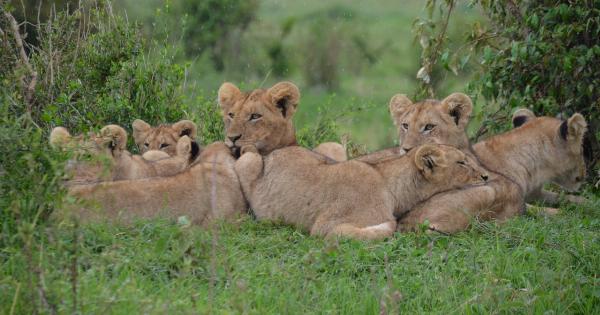Group of lions with insect infestation put down following lengthy coexistence.
Understanding the Coexistence
In the vast plains of Africa, where the circle of life revolves endlessly, a group of lions once roamed freely through the savannah.
For many years, this pride of lions lived harmoniously with the surrounding wildlife, creating a delicate balance within the ecosystem. However, recent events have forced authorities to make a heart-wrenching decision, resulting in the tragic demise of the pride.
The Rising Plight
Over time, the once-thriving pride of lions began to face a unique challenge – an infestation of insects that plagued the majestic creatures.
These tiny but relentless creatures, believed to be tsetse flies, became a significant issue for the lions’ health and well-being. The insects swarmed around the lions, incessantly biting and causing a variety of health problems, including acute discomfort, infections, and even lethal diseases.
This infestation left the lions weakened and vulnerable.
Their ability to hunt and maintain their dominance within the animal kingdom was significantly diminished, impacting the lionesses’ ability to provide for their cubs and ensuring their survival. The pride’s once formidable reign was now in jeopardy, and human intervention became inevitable.
The Difficult Decision
Wildlife experts and conservationists closely monitored the situation, observing the pride’s struggles and evaluating potential solutions.
However, after years of searching for alternative methods to combat the infestation, it became evident that the pride’s suffering was beyond recovery.
The insects had not only taken a debilitating toll on the lions but had also begun to wreak havoc on the surrounding ecosystem.
The delicate balance that once existed was slowly crumbling, threatening the existence of other species that coexisted with the pride. Amidst this grim scenario, authorities were left with no choice but to intervene and prevent further damage to the ecosystem and potential spread of the insect infestation.
The Ethical Debate
Although the decision to put down the pride was a difficult one, it was not made without intense ethical deliberations.
Several factors were considered, including the potential long-term implications of the lions’ continued suffering and the overall welfare of the entire ecosystem.
Conservationists, animal rights activists, and experts worldwide engaged in heated debates regarding the morality of the decision.
While some argued that nature should be left unaltered and allowed to find its own equilibrium, others claimed that intervening was a necessary evil to protect the balance of the ecosystem and prevent further suffering.
Ultimately, after thorough consultations and rigorous studies conducted by leading scientists, the decision was made to end the lions’ suffering in the most humane manner possible.
The Intervention Process
Carrying out the intervention process required meticulous planning, as the authorities aimed to minimize any potential damage to the ecosystem while ensuring the lions were relieved of their torturous existence.
A team of expert wildlife veterinarians, armed with sedatives and specialized equipment, embarked on a mission to end the lions’ prolonged suffering.
The intervention process involved tracking and locating the pride, carefully approaching them, and administering a sedative to induce a peaceful slumber.
Once the lions were safely sedated, they were transported to a designated location, away from other wildlife and human settlements, to carry out the necessary procedures.
Under the watchful eyes of the veterinary team, the lions were humanely euthanized, freeing them from the torment inflicted upon them by the infestation.
The veterinarians ensured that the pride passed away with dignity, experiencing no pain or distress in their final moments.
The Aftermath
The decision, execution, and aftermath of the intervention sparked a widespread debate throughout the conservation community.
While some commended the intervention as a necessary step to restore balance, others criticized the decision as an infringement upon nature’s course, questioning the extent of human interference in the natural world.
Nevertheless, the intervention allowed other species within the ecosystem to recover from the damaging consequences of the infestation.
With the threat of the insects eliminated, the variety of wildlife that shared the territory with the lions experienced a resurgence in population and livelihood.
The local communities, once affected by the insects as well, saw improvements in their overall well-being, as the threat of insect-borne diseases diminished significantly.
The intervention brought about a renewed sense of optimism and hope for the region, despite the tragic end to the pride’s story.
Lessons Learned
The intervention with the group of lions and the subsequent repercussions taught valuable lessons to both conservationists and the global community.
Firstly, it emphasized the intricate interconnectedness of all species within an ecosystem. The well-being of one species can have a direct impact on the flourishing or decline of others.
Neglecting or prioritizing certain species over others can disrupt the balance and eventually lead to irreversible consequences.
Secondly, it sparked discussions about the boundaries of human intervention in the natural world.
While the decision to euthanize the pride was undoubtedly difficult, it served as a reminder that humans have a responsibility to protect and conserve delicate ecosystems when faced with unprecedented challenges.
Lastly, the intervention sheds light on the importance of ongoing research and preventive measures.
Efforts to monitor and understand the complexities of ecological systems can help in identifying potential issues and finding alternative solutions that avoid such extreme interventions.
Conclusion
The group of lions that once roamed the African savannah faced a daunting and relentless challenge in the form of a debilitating insect infestation.
After years of suffering and a thorough evaluation of the situation, the authorities made the somber decision to euthanize the pride in the best interest of the ecosystem and to prevent further torment.
The intervention process was carried out with utmost care and consideration, recognizing the ethical implications of such an intervention.
Despite the controversy and mixed opinions surrounding the decision, it ultimately led to the restoration of balance within the ecosystem and improved the overall well-being of the region for both wildlife and human communities.






























